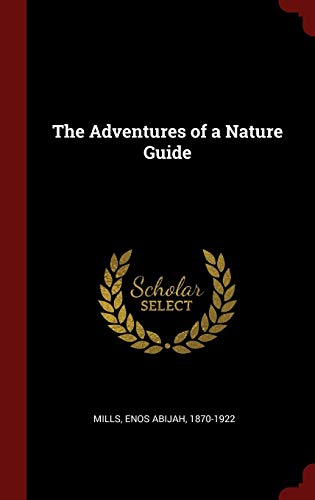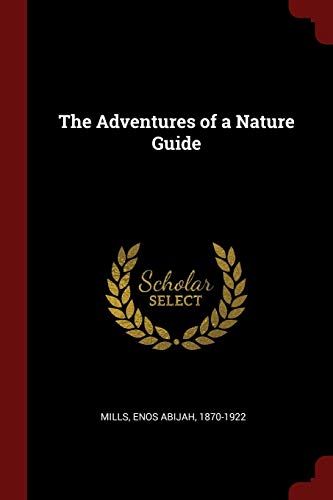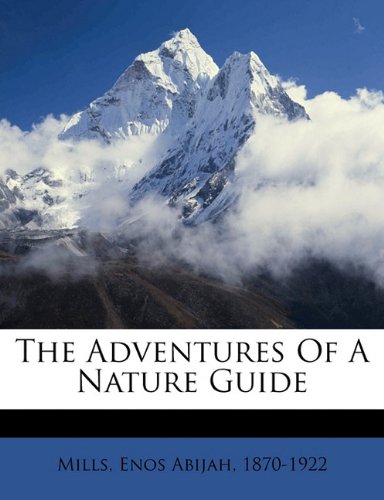-
Wild Life on the Rockies
Enos Abijah Mills
eBookThis book was converted from its physical edition to the digital format by a community of volunteers. You may find it for free on the web. Purchase of the Kindle edition includes wireless delivery.
-
The Adventures of a Nature Guide
Enos Abijah Mills
eBookEnos Abijah Mills (1870 –1922) was an American naturalist and homesteader. He was the main figure behind the creation of Rocky Mountain National Park. Mills was born just outside Pleasanton, Kansas, near the Civil War Mine Creek Battlefield site, but moved to Colorado early in his life during a bout with tuberculosis. In 1889, he had a chance encounter with famed naturalist John Muir on a San Francisco beach, and from that point on Mills dedicated his life to conservation activism, lecturing, and writing. In 1902, Mills returned to Colorado and purchased from his cousin the Longs Peak House in Estes Park. He eventually homesteaded in the surrounding area and later turned the Longs Peak house into the Longs Peak Inn, from which he treated guests to excursions into the wilderness and evening nature talks.From 1902–1906, Mills also served as the Colorado State Snow Observer, a position that took him into the wild he so loved. His job was to measure the snow depths to predict spring and summer runoff. Following this position, he served as government lecturer on forestry from 1907–1909. During this time, he also authored several articles and books on nature and Estes Park area.Throughout his time in various assignments, Mills was also leading the fight to preserve the area around Longs Peak as a national park. Aided by groups such as the Sierra Club and the Daughters of the American Revolution, Mills succeeded and Congress established Rocky Mountain National Park in 1915. Called the "Father of Rocky Mountain National Park," Mills continued to lecture and write books until his death at age 52 in 1922. Mills Lake in Rocky Mountain National Park is named in his honor.CONTENTSI. Snow-blinded On The Summit II. Waiting In The Wilderness III. Winter Mountaineering IV. Trees At Timberline V. Wind-rapids On The Heights VI. The Arctic Zone Of High Mountains VII. Naturalist Meets Prospector VIII. The White Cyclone IX. Lightning And Thunder X. Landmarks XI. Children Of My Trail School XII. A Day With A Nature Guide XIII. Play And Pranks Of Wild Folk XIV. Censored Natural History News XV. Harriet—Little Mountain Climber XVI. Evolution Of Nature Guiding XVII. Development Of A Woman Guide This book originally published in 1920 has been reformatted for the Kindle and may contain an occasional defect from the original publication or from the reformatting.
-
The Grizzly Our Greatest Wild Animal
1870-1922 Mills, Enos Abijah
language (HardPress, June 23, 2016)HardPress Classic Books Series
-
The Grizzly Our Greatest Wild Animal
1870-1922 Mills, Enos Abijah
language (HardPress, June 23, 2016)HardPress Classic Books Series
-
The Adventures of a Nature Guide
Enos Abijah Mills
Paperback (Andesite Press, Aug. 21, 2017)This work has been selected by scholars as being culturally important, and is part of the knowledge base of civilization as we know it. This work was reproduced from the original artifact, and remains as true to the original work as possible. Therefore, you will see the original copyright references, library stamps (as most of these works have been housed in our most important libraries around the world), and other notations in the work.This work is in the public domain in the United States of America, and possibly other nations. Within the United States, you may freely copy and distribute this work, as no entity (individual or corporate) has a copyright on the body of the work.As a reproduction of a historical artifact, this work may contain missing or blurred pages, poor pictures, errant marks, etc. Scholars believe, and we concur, that this work is important enough to be preserved, reproduced, and made generally available to the public. We appreciate your support of the preservation process, and thank you for being an important part of keeping this knowledge alive and relevant.
-
The Adventures of a Nature Guide
Enos Abijah 1870-1922 Mills
Hardcover (Andesite Press, Aug. 8, 2015)This work has been selected by scholars as being culturally important, and is part of the knowledge base of civilization as we know it. This work was reproduced from the original artifact, and remains as true to the original work as possible. Therefore, you will see the original copyright references, library stamps (as most of these works have been housed in our most important libraries around the world), and other notations in the work.This work is in the public domain in the United States of America, and possibly other nations. Within the United States, you may freely copy and distribute this work, as no entity (individual or corporate) has a copyright on the body of the work.As a reproduction of a historical artifact, this work may contain missing or blurred pages, poor pictures, errant marks, etc. Scholars believe, and we concur, that this work is important enough to be preserved, reproduced, and made generally available to the public. We appreciate your support of the preservation process, and thank you for being an important part of keeping this knowledge alive and relevant.
-
In Beaver World
Enos Abijah Mills
language (, May 5, 2013)The beaver often does a large amount of work in a short time. A small dam may be built up in a few nights, or a number of trees felled, or possibly a long burrow or tunnel clawed in the earth during a brief period. In most cases, however, beaver works of magnitude are monuments of old days, and have required a long time to construct, being probably the work of more than one generation. It is rare for a large dam or canal to be constructed in one season. A thousand feet of dam is the accumulated work of years. An aged beaver may have lived all his life in one locality, born in the house in which his parents were born, and he might rise upon the thousand-foot dam which held his pond and say, “My grandparents half a dozen centuries ago commenced this dam, and I do not know which one of my ancestors completed it.”Although the beaver is a tireless and an effective worker, he does not work unless there is need to do so. Usually his summer is a rambling vacation spent away from home. His longest period of labor is during September and October, when the harvest is gathered and general preparations made for the long winter. Baby beavers take part in the harvest-getting, though probably without accomplishing very much. During most winters he has weeks of routine in the house and ponds with nothing urgent to do except sleep and eat.He works not only tooth and nail, but tooth and tail. The tail is one of the most conspicuous organs of the beaver. Volumes have been written concerning it. It is nearly flat, is black in color, and is a convenient and much-used appendage. It serves for a rudder, a stool, a prop, a scull, and a signal club. It may be used for a trowel, but I have never seen it so used. It serves one purpose that apparently has not been discussed in print; on a few occasions I have seen a beaver carry a small daub of mud or some sticks clasped between the tail and the belly. It gives this awkward animal increased awkwardness and even an uncouth appearance to see him humped up, with tail tucked between his legs, in order to clasp something between it and his belly.He is accomplished in the use of arms and hands. With hands he is able to hold sticks and handle them with great dexterity. Like any clawing animal he uses his hands or fore paws, to dig holes or tunnels and to excavate burrows and water-basins. His hind feet are the chief propelling power in swimming, although the tail, which may be turned almost on edge and is capable of diagonal movement, is sometimes brought into play as a scull when the beaver is at his swiftest. In the water beaver move about freely and apparently with the greatest enjoyment. They are delightfully swift and agile swimmers, in decided contrast with their awkward slowness upon the ground. They can swim two hundred yards under water without once coming to the surface, and have the ability to remain under water from five to ten minutes. On one occasion a beaver remained under water longer than eleven minutes, and came to the top none the worse, apparently, for this long period of suspended breathing.It is in standing erect that the beaver is at his best. In this attitude the awkwardness and the dull appearance of all-fours are absent, and he is a statue of alertness. With feet parallel and in line, tail at right angles to the body and resting horizontally on the ground, and hands held against the breast, he has the happy and childish eagerness of a standing chipmunk, and the alert and capable attitude of an erect and listening grizzly bear.In Beaver World, The Beaver Dam, Transportation Facilities, The Beaver’s Engineering, Beaver Pioneers, Beaver Ponds, Aspens cut by Beaver
-
The Adventures of a Nature Guide
Enos Abijah 1870-1922 Mills
Paperback (Andesite Press, Aug. 23, 2017)This work has been selected by scholars as being culturally important, and is part of the knowledge base of civilization as we know it. This work was reproduced from the original artifact, and remains as true to the original work as possible. Therefore, you will see the original copyright references, library stamps (as most of these works have been housed in our most important libraries around the world), and other notations in the work.This work is in the public domain in the United States of America, and possibly other nations. Within the United States, you may freely copy and distribute this work, as no entity (individual or corporate) has a copyright on the body of the work.As a reproduction of a historical artifact, this work may contain missing or blurred pages, poor pictures, errant marks, etc. Scholars believe, and we concur, that this work is important enough to be preserved, reproduced, and made generally available to the public. We appreciate your support of the preservation process, and thank you for being an important part of keeping this knowledge alive and relevant.
-
In Beaver World
Enos Abijah Mills
language (, March 9, 2013)Excerpt:This book is the result of beaver studies which cover a period of twenty-seven years. During these years I have rambled through every State in the Union and visited Mexico, Canada, and Alaska. In the course of these rambles notice was taken of trees, birds, flowers, glaciers, and bears, and studious attention devoted to the beaver. No opportunity for beaver study was missed, and many a long journey was made for the purpose of investigating the conditions in live colonies or in making measurements in the ruins of old ones. These investigations were made during every season of the year, and often a week was spent in one colony. I have seen beaver at work scores of times, and on a few occasions dozens at one time.Beaver have been my neighbors since I was a boy. At any time during the past twenty-five years I could go from my cabin on the slope of Long’s Peak, Colorado, to a number of colonies within fifteen minutes. Studies were carried on in these near-by colonies in spring, summer, autumn, and winter.
-
In Beaver World
Enos Abijah Mills
language (, March 9, 2013)This book is the result of beaver studies which cover a period of twenty-seven years. During these years I have rambled through every State in the Union and visited Mexico, Canada, and Alaska. In the course of these rambles notice was taken of trees, birds, flowers, glaciers, and bears, and studious attention devoted to the beaver. No opportunity for beaver study was missed, and many a long journey was made for the purpose of investigating the conditions in live colonies or in making measurements in the ruins of old ones. These investigations were made during every season of the year, and often a week was spent in one colony. I have seen beaver at work scores of times, and on a few occasions dozens at one time.Beaver have been my neighbors since I was a boy. At any time during the past twenty-five years I could go from my cabin on the slope of Long’s Peak, Colorado, to a number of colonies within fifteen minutes. Studies were carried on in these near-by colonies in spring, summer, autumn, and winter.One autumn my entire time was spent in making observations and watching the activities of beaver in fourteen colonies. Sixty-four days in succession I visited these colonies, three of them twice daily. These daily investigations enabled me to see the preparations for winter from beginning to end. They also enabled me to understand details which with infrequent visits I could not have even discovered. During this autumn I saw two houses built and a number of old ones repaired and plastered. I also saw the digging of one canal, the repairing of a number of old dams, and the building of two new ones. In three of these colonies I tallied each day the additional number of trees cut for harvest. I saw many trees felled, and noted the manner in which they were moved by land and floated by water.The greater number of the papers in this book were written especially for it. Parts of the others have been used in my books Wild Life on the Rockies and The Spell of the Rockies. “The Beaver’s Engineering” appeared in the Saturday Evening Post, and I am indebted to McClure’s for permission to use “Beaver Pioneers.”Beaver works are of economical and educational value besides adding a charm to the wilds. The beaver is a persistent practicer of conservation and should not perish from the hills and mountains of our land. Altogether the beaver has so many interesting ways, is so useful, skillful, practical, and picturesque that his life and his deeds deserve a larger place in literature and in our hearts.
-
The adventures of a nature guide
Enos Abijah 1870-1922 Mills
Paperback (Nabu Press, Oct. 14, 2010)This is a reproduction of a book published before 1923. This book may have occasional imperfections such as missing or blurred pages, poor pictures, errant marks, etc. that were either part of the original artifact, or were introduced by the scanning process. We believe this work is culturally important, and despite the imperfections, have elected to bring it back into print as part of our continuing commitment to the preservation of printed works worldwide. We appreciate your understanding of the imperfections in the preservation process, and hope you enjoy this valuable book.
-
The Grizzly, Our Greatest Wild Animal
Enos Abijah 1870-1922 Mills
Hardcover (Wentworth Press, Aug. 26, 2016)This work has been selected by scholars as being culturally important, and is part of the knowledge base of civilization as we know it. This work was reproduced from the original artifact, and remains as true to the original work as possible. Therefore, you will see the original copyright references, library stamps (as most of these works have been housed in our most important libraries around the world), and other notations in the work.This work is in the public domain in the United States of America, and possibly other nations. Within the United States, you may freely copy and distribute this work, as no entity (individual or corporate) has a copyright on the body of the work.As a reproduction of a historical artifact, this work may contain missing or blurred pages, poor pictures, errant marks, etc. Scholars believe, and we concur, that this work is important enough to be preserved, reproduced, and made generally available to the public. We appreciate your support of the preservation process, and thank you for being an important part of keeping this knowledge alive and relevant.